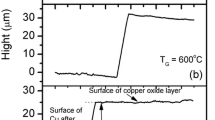Abstract
Metal oxide nanowire-based devices have been widely studied for chemical sensors. Based on the knowledge of the work functions of copper oxide nanowires and metal electrodes, the electrical junction properties such as Schottky barrier height could be modulated by changing the electrode material or decorating the nanowires with another material. Especially for the nanowire decoration process, nanoparticle sputtering or wet chemical synthesis has been used as a post processing method, which is complex and costly. These drawbacks have greatly limited the actual applications of the nanowire-based devices. In this work, a facile one-step thermal oxidation of electroplated interdigitated Cu patterns is proposed for multiple copper oxide nanowire-based device fabrication and a modulation mechanism based on adjusting nanowire density and total area of CuO/Cu–Au interface is discussed. The initial thickness of Cu and the electrode configuration play a deterministic role in the final CuO nanowire morphologies and their junction properties, which is a new finding.






Similar content being viewed by others
References
Bercu B, Geng W, Simonetti O, Kostcheev S, Sartel C, Vincent S et al (2013) Characterisations of ohmic and Schottky contacts of a single ZnO nanowire. Nanotechnology 24:415202–415211
Comini E, Sberveglieri G (2010) Metal oxide nanowires as chemical sensors. Mater Today 13:36–44
Hu Y, Zhou J, Yeh P-H, Li Z, Wei T-Y, Wang ZL (2010) Supersensitive, fast-response nanowire sensors by using Schottky Contacts. Adv Mater 22:3327–3332
Jiang X, Herricks T, Xia Y (2002) CuO nanowires can be synthesized by heating copper substrates in air. Nano Lett 2:1333–1338
Kim Y-S, Hwang I-S, Kim S-J, Lee C-Y, Lee J-H (2008) CuO nanowire gas sensors for air quality control in automotive cabin. Sensors Actuators B Chem 135:198–303
Kolmakov A, Moskovits M (2004) Chemical sensing and catalysis by one-dimensional metal-oxide nanostructures. Annu Rev Mater Res 34:151–180
Lai F-C, Lin S-Z, Chen Z-G, Hu H-L, Lin L-M (2013) Wrinkling and growth mechanism of CuO nanowires in thermal oxidation of copper foil. Chin J Chem Phys 26:585–589
Liao L, Zhang Z, Yan B, Zheng Z, Bao QL, Wu T et al (2009) Multifunctional CuO nanowire devices: p-type field effect transistors and CO gas sensors. Nanotechnology 20:085203
Lim Y-F, Chua CS, Lee CJJ, Chi D (2014) Sol–gel deposited Cu2O and CuO thin films for photocatalytic water splitting. Phys Chem Chem Phys 16:25928–25934
Lupan O, Postica V, Cretu V, Wolff N, Duppel V, Kienle L et al (2016) Single and networked CuO nanowires for highly sensitive p-type semiconductor gas sensor applications. Phys Status Solidi (RRL) Rapid Res Lett 10:260–266
Maruyama T (1998) Copper oxide thin films prepared by chemical vapor deposition from copper dipivaloylmethanate. Sol Energy Mater Sol Cells 56:85–92
Morales J, Sanchez L, Martin F, Ramos-Barrado JR, Sanchez M (2005) Use of low-temperature nanostructured CuO thin films deposited by spray-pyrolysis in lithium cells. Thin Solid Films 474:133–140
Reddy AS, Park H-H, Reddy VS, Reddy KVS, Sarma NS, Kaleemulla S et al (2008) Effect of sputtering power on the physical properties of dc magnetron sputtered copper oxide thin films. Mater Chem Phys 110:397–401
Richharia P, Chopra KL, Bhatnagar MC (1991) Surface analysis of a black copper selective coating. Solar Energy Mater 23:93–109
Schipani F, Aldao CM, Ponce MA (2012) Schottky barriers measurements through Arrhenius plots in gas sensors based on semiconductor films. AIP Adv 2:032138
Steinhauer S, Brunet E, Maier T, Mutinati GC, Kock A (2012) “On-Chip Synthesis of CuO Nanowires for Direct Gas Sensor Integration” presented at the 12th IEEE International Conference on Nanotechnology (IEEE-NANO). The International Conference Centre Birmingham, Birmingham
Steinhauer S, Singh V, Cassidy C, Gspan C, Grogger W, Sowwan M et al (2015) Single CuO nanowires decorated with size-selected Pd nanoparticles for CO sensing in humid atmosphere. Nanotechnology 26:175502–175508
Voinea M, Vladuta C, Bogatu C, Duta A (2008) Surface properties of copper based cermet materials. Mater Sci Eng B 152:76–80
Wang X, Church J, Lee WH, Cho HJ (2015) Phosphate sensors based on Co–Cu electrodes fabricated with a sacrificial glass fiber paper template. In: 2015 IEEE SENSORS, Busan, South Korea
Zhang P, Vincent A, Kumar A, Seal S, Cho HJ (2010) A low-energy room-temperature hydrogen nanosensor: utilizing the Schottky barriers at the electrode/sensing-material interfaces. IEEE Electron Device Lett 31:770–772
Acknowledgements
This work was supported in part by the NSF I/UCRC on Multi-functional Integrated System Technology (MIST Center) IIP-1439644 and IIP-1439680. The authors thank Dr. Kyle Renshaw and Mr. Zhao Ma for electron-beam deposition of gold, and Mr. Kirk Scammon for assistance with TF-XRD and SEM analysis, which were carried out at Materials Characterization Facility, AMPAC, University of Central Florida. The authors also thank Dr. Sanghoon Park and Mr. Christopher Hughes’s assistance on device electrical property characterization.
Author information
Authors and Affiliations
Corresponding author
Rights and permissions
About this article
Cite this article
Wang, X., Cho, H.J. Morphologies and electrical properties of multiple CuO nanowire-based device controlled by electroplating and thermal oxidation process. Microsyst Technol 24, 2719–2726 (2018). https://doi.org/10.1007/s00542-017-3664-6
Received:
Accepted:
Published:
Issue Date:
DOI: https://doi.org/10.1007/s00542-017-3664-6




